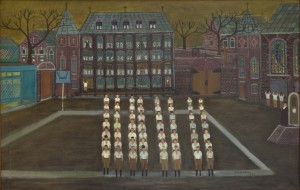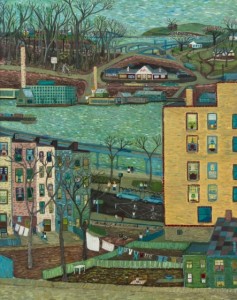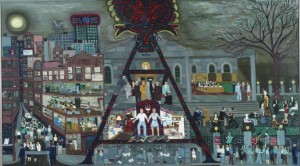Ralph Fasanella: A More Perfect Union
Ralph Fasanella’s first gallery retrospective celebrates New York City’s bridges, skylines, and tenements; your neighbors, my neighbors, our memories and our aspirations. These pictures draw you in to conversations. You cannot help but stop to comment on them to your friends, the stranger next to you at the gallery, who will soon bond with you excitedly over a painting on view. These pictures chat with you conversationally, sometimes in the inflected speech of past generations, they raise their voices in chants on the picket lines of strikes, and sometimes let you hear the murmur of the waters near the old textile and paper mills across the river.
The first painting that greets you as you enter the Andrew Edlin Gallery, now showing the paintings of Lincoln Vet Ralph Fasanella, is “Catholic Protectory Line-Up”, painted in 1961. The Catholic Protectory was an orphanage as well as a reform school, where Fasanella served two stints as a truant and runaway. It’s a fitting introduction to this show spanning fifty years of his career. The boys are rigidly standing at attention in uniforms whose vertical stripes echo the oppressive grid formed by metal fences, slate roofs, barren branches, the brickwork facade of the institution and the austere robes of the menacing priests. It introduces us not only to the early biography of the artist, but to the themes which will recur in later works throughout his career. The baseball played in the orphanages of that era will show up again in the exuberance of Willie Mays painted playing at the Polo Grounds, or another more brightly colored oil of boys playing stickball on NYC streets. The complex geometric elements, and symbols of the church and bare trees will be used again with different palettes and subjects to evoke highly contrasting moods and memories.
 Perhaps the most unique feature which we first see here is the honesty and inclusiveness of this artist’s world. Fasanella takes us through his own personal and the country’s collective memory in this show. He shows us the impoverished reform school boys of the 1920’s and the children of striking Lawrence, Mass. Textile workers in the gallery’s last and largest image. He engages us with history, sometimes painful, such as the assassination of JFK or the execution of the Rosenbergs, and sometimes celebratory of organization and resistance, such as the “Daily News Strike”, but always expanding our definition of American art, and America.
Perhaps the most unique feature which we first see here is the honesty and inclusiveness of this artist’s world. Fasanella takes us through his own personal and the country’s collective memory in this show. He shows us the impoverished reform school boys of the 1920’s and the children of striking Lawrence, Mass. Textile workers in the gallery’s last and largest image. He engages us with history, sometimes painful, such as the assassination of JFK or the execution of the Rosenbergs, and sometimes celebratory of organization and resistance, such as the “Daily News Strike”, but always expanding our definition of American art, and America.
The gallery is a narrow space which opens into a large, brightly lighted back room. They have cleverly used the passageway, lining it with smaller, early works, some debuting here for the first time. “Across the River”, 1969, is one such work.
The urban side of the river shows a multiracial community using the parks and streets to play games, sit on the stoop and stroll along the river. The windows in the tenements are likewise full of human activity. Across the river are what appear to be factory plants and further in, houses, populated by a lone bicyclist. Even the stylized trees, which reappear here, begin to bear blossoms on the “other side.”
 The triangular body of water dividing the two sides becomes a triangular lunch counter in “Harry’s Luncheonette,” on the wall next to this picture. The unsettling off center perspective is reminiscent of Edward Hopper’s iconic “Night Hawks”, who also populate an urban café. While the canvas is fuller than Hopper’s, with details such as hanging laundry or graffiti covered apartment buildings, the unusual vantage point of patrons whose backs are turned to the viewer is equally as distancing as a Hopper and does not allow us to easily enter the pictorial space.
The triangular body of water dividing the two sides becomes a triangular lunch counter in “Harry’s Luncheonette,” on the wall next to this picture. The unsettling off center perspective is reminiscent of Edward Hopper’s iconic “Night Hawks”, who also populate an urban café. While the canvas is fuller than Hopper’s, with details such as hanging laundry or graffiti covered apartment buildings, the unusual vantage point of patrons whose backs are turned to the viewer is equally as distancing as a Hopper and does not allow us to easily enter the pictorial space.
Staying with the show will reward you with the largest and most complex works in the last room. The 40 x 90 inch “American Tragedy” is now using the geometrics, minutely observed details and the early symbolism to provide not only a depiction of JFK’s assassination, but through visual means, an analysis of the social forces of the time which brought us to this tragic day. Facing it are two murals dealing with the Rosenberg execution, painted in 1954 and 1963 respectively. We benefit from seeing this grouping together, as the symbols and motifs in one oil help to elucidate variations on them in another. For example, the triangular electric gird/chair at the Center of “The Rosenberg’s Gray Day” appear as the flag draped oil well like missiles in “American Tragedy”, whose central totem is filled with the triangular white hoods of the Klan, including one topping Jack Ruby’s head.
My only suggestion for the show is that younger visitors might benefit from labels identifying the works, as one person I spoke to at the gallery did not recognize the subject matter in the two paintings dealing with the Rosenbergs. The earlier one, “McCarthy Era Garden Party”, takes a more satiric tone and lighter, green, garden like palette. The military, and “one percenters” are depicted getting drunk and passing out in their victory, even as protestors ring the periphery of the canvas. The 1963 “Gray Day”, painted within a year of “American Tragedy” is a more ambitious canvas. The Rosenbergs are shown with their family and their books , over their stark cells on death row. We see a more nuanced portrait of the family. Perhaps the passage of time allowed the artist to revisit the somber day, recording the gray rain that poured down on the protestors and on the nation’s soul.
 The Edlin Gallery is directly facing Chelsea’s Highline park. Looking down from the heights of the highline after the show, it was impossible not to see the surrounding cityscape cast in the pulsating geometric architecture of the paintings on display across the street. Like any great painter, he imprinted his vision, both figurative and literal, on the viewer. You will come away from the show seeing the doors, windows, skyscrapers, people and issues of our day, a little bit deeper and a little bit differently
The Edlin Gallery is directly facing Chelsea’s Highline park. Looking down from the heights of the highline after the show, it was impossible not to see the surrounding cityscape cast in the pulsating geometric architecture of the paintings on display across the street. Like any great painter, he imprinted his vision, both figurative and literal, on the viewer. You will come away from the show seeing the doors, windows, skyscrapers, people and issues of our day, a little bit deeper and a little bit differently
Nancy Wallach is the daughter of Abraham Lincoln Brigade Veteran Hy Wallach













As a Fasanella fan, I found your descriptions and explanations of his work at the Edlin Gallery clear and illuminating. This legacy by a Veteran of the Abraham Lincoln Brigade who fought for the liberty of others in another country, Spain, reminds us that the need for justice for all members of our society should not be taken for granted and the struggle to achieve it must continue. Thank you for sharing your visit.
Jo Yurek
As one who has long enjoyed Ralph Fasanella’s works for their richly deep portraits of past times, I was pleasantly surprised- probably shouldn’t have been- that he was a Vet of the ALB. All the more then did I enjoy this very perceptive review, which places his work squarely in the context of his times. Thank you for expanding perspectives!
Brian O’Malley, MD